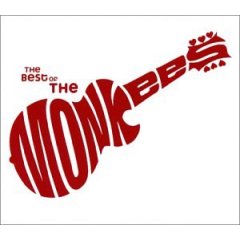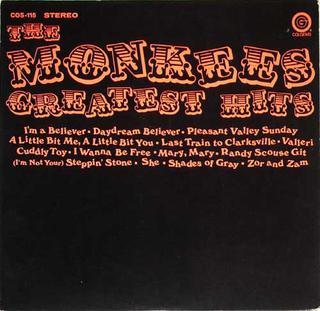
David Thomas Jones was an English actor and singer. Best known as a member of the band The Monkees and a co-star of the TV series The Monkees (1966–1968), Jones was considered a teen idol.

The Monkees were an American pop rock band formed in Los Angeles in the mid-1960s. The band consisted of Micky Dolenz, Davy Jones, Michael Nesmith, and Peter Tork. Spurred by the success of the television show of the same name, the Monkees were one of the most successful bands of the late 1960s. With international hits, four chart-topping albums and three chart-topping songs, they sold more than 75 million records worldwide.

George Michael Dolenz Jr. is an American musician and actor. He was the drummer and one of two primary vocalists for the pop-rock band the Monkees, and a co-star of the TV series The Monkees (1966–1968).

Pisces, Aquarius, Capricorn & Jones Ltd. is the fourth album by the Monkees. It was released on November 6, 1967, during a period when the band exerted more control over their music and performed many of the instruments themselves. However, although the group had complete artistic control over the procceedings, they invited more outside contributions than on their previous album, Headquarters, and used session musicians to complement their sound. The album also featured one of the first uses of the Moog synthesizer in popular music. Pisces, Aquarius, Capricorn & Jones Ltd. sold over three million copies. It was the band's fourth consecutive album to reach No. 1 on the U.S. Billboard 200.

The Monkees is the debut studio album by the American band the Monkees. It was released on October 10, 1966 by Colgems Records in the United States and RCA Victor in the rest of the world. It was the first of four consecutive U.S. number one albums for the group, taking the top spot on the Billboard 200 for 13 weeks, after which it was displaced by the band's second album. It also topped the UK charts in 1967. The Monkees has been certified quintuple platinum by the RIAA, with sales of over five million copies.

The Best of the Monkees is a Monkees compilation released by Rhino Entertainment. It contains 25 songs from the Monkees' repertoire, listed in chronological order by release date. Also included is a bonus karaoke CD with five tracks. Unlike previous Rhino compilations, this one does not include any material from the 1980s or 1990s reunions, focusing strictly on the band's 1960s output.

Pool It! is the tenth studio album by American pop rock band the Monkees, released in August 1987 by Rhino Records. It was the first Monkees studio album of new material since Changes in 1970 and the first Monkees album to feature Peter Tork since the 1968 Head soundtrack.

Then & Now... the Best of The Monkees is a compilation album of songs by the 1960s American pop group the Monkees, released by Arista Records in 1986.
"Shades of Gray" is a song which was written by Barry Mann and Cynthia Weil, and recorded by The Monkees for their 1967 album Headquarters. Lead vocals were shared by Davy Jones and Peter Tork, and this is the only track on the album featuring instruments performed by session musicians instead of the band members themselves.

The Monkees Greatest Hits is the first greatest hits compilation album by the American pop rock band the Monkees, released in 1969 by Colgems Records.

"Pleasant Valley Sunday" is a song by Gerry Goffin and Carole King, recorded and released by the Monkees in the summer of 1967. Inspired by their move to West Orange, New Jersey, and named for a street there, Goffin and King wrote the song about their dissatisfaction with life in the suburbs.

"A Little Bit Me, a Little Bit You" is a song written by Neil Diamond, recorded by the Monkees in 1967 and released as a single on the Colgems label. The lead vocal was Davy Jones' first on a Monkees single. The single reached No. 1 on the Cashbox Top 100 chart, while on the Billboard Hot 100 it reached No. 2, with "Somethin' Stupid" by Frank Sinatra and Nancy Sinatra keeping it from the top spot.

"Randy Scouse Git" is a song written by Micky Dolenz in 1967 and recorded by the Monkees. It was the first song written by Dolenz to be commercially released, and it became a number 2 hit in the UK where it was retitled "Alternate Title" after the record company (RCA) complained that the original title was actually somewhat "rude to British audience" and requested that The Monkees supply an alternate title. Dolenz took the song's title from a phrase he had heard spoken on an episode of the British television series Till Death Us Do Part, which he had watched while in England. The song also appeared on The Monkees TV series, on their album Headquarters, and on several "Greatest Hits" albums. Peter Tork said that it was one of his favorite Monkees tracks.

Tear Drop City is a single by The Monkees released on February 8, 1969 on Colgems #5000 recorded on October 26, 1966. The song reached No.56 on the Billboard chart, no.37 on cash box. The lyrics are about a man who feels low because his girlfriend has left him. Written by Tommy Boyce and Bobby Hart, it was the first single The Monkees released as a trio. Micky Dolenz performed the lead vocal. Boyce and Hart produced and arranged the song.

The Definitive Monkees is a limited edition Monkees compilation album released in 2001. It contains 29 of the Monkees' greatest hits. The album includes two tracks from the 1980s reunions. The album featured a bonus disc which featured 31 of The Monkees' rarity songs.

"The Girl I Knew Somewhere" is a song by the American pop rock band the Monkees, written by Michael Nesmith and first released as the B-side to the "A Little Bit Me, a Little Bit You" single on Colgems Records on March 8, 1967. It was distributed in support of the group's third album Headquarters, and later appeared on the reissued version of the LP. The song was recorded as the Monkees finally achieved the independence that enabled them to freely produce their own material, with the actual band members featured on both vocals and instrumental arrangements.

"Goin' Down" is a song by the American pop rock band the Monkees, written by all four members of the group along with Diane Hildebrand. It was first released as the B-side to the "Daydream Believer" single on Colgems Records on October 25, 1967, in support of the band's fourth album, Pisces, Aquarius, Capricorn & Jones Ltd. The song managed to bubble under the Billboard Hot 100 upon its release.

Good Times! is the twelfth studio album by American pop rock band the Monkees. Produced primarily by Adam Schlesinger, the album was recorded to commemorate the band's 50th anniversary. It is the first Monkees studio album since Justus (1996), marking the longest gap between releases to date, and the first since the death of Davy Jones. The album features surviving Monkees Micky Dolenz, Michael Nesmith, and Peter Tork, as well as a posthumous contribution from Jones.
"Christmas Is My Time of Year" is a Christmas single written by Howard Kaylan and Chip Douglas, both members of the Turtles.
"Words" is a song written by Tommy Boyce and Bobby Hart and released by the Monkees. An early version by the Leaves appeared on their 1966 album Hey Joe. The Monkees first recorded the song for their second album, More of The Monkees, in August 1966 under the supervision of Boyce and Hart. While this version went unreleased until the 1990 compilation Missing Links Volume Two, it was featured in the 10 April 1967 episode of The Monkees "Monkees, Manhattan Style". A new version of the song was made to be the B-side of "Pleasant Valley Sunday" in 1967, now produced by Chip Douglas.


















